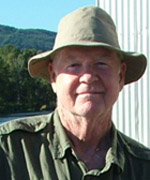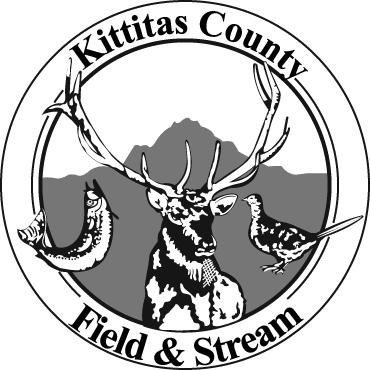Archive for July, 2015
Warm Water, Low Oxygen, Dead Salmon
If you have seen or heard any print, visual or audio media in the past couple weeks, you know something about the effects of this Northwest summer’s heat and drought on our fish, and our fishing.
You have likely seen the photos and video of dying sturgeon on the Columbia – 20- to 40-year-old fish suddenly unable to survive. You may have read that half of the salmon heading up the Columbia to make more fish (our future fisheries and food) are severely stressed and dying.
If you – like many of us in Paradise – look forward to summer fishing for salmon and all the other fish which bring us pleasure on the water and at the table, you have probably shared my dismay at the rise in emergency closures related to low flows and high temperatures.
Over the last couple weeks, in our region alone, the Upper Columbia River has been closed to sockeye salmon retention (Rocky Reach to Chief Joseph dams), along with the Wenatchee, Icicle and a reach of the Okanogan. Other closures include all forks of the Teanaway and the Little Naches. Fishing in a number of creeks and lakes (including Lake Wenatchee) was shut down to protect stressed fish stocks. The Naches River (Tieton to Bumping/Little Naches) and Rattlesnake Creek are under “hoot-owl” restrictions, meaning fishing is allowed only between Midnight and 2 p.m. Hatcheries around the state are taking strong measures to protect young fish. It’s a difficult year for those among us who live in water.
(Not all is bad news: fisheries pros determined that the sockeye going up the Wenatchee River into Lake Wenatchee are in good shape, and opened the lake’s sockeye season yesterday with a daily four-fish limit.)
I reached out to homey and fish pro David Child (www.dreamflyfishing.com) for his take on this summer’s fishing and he suggested I have a chat with Tobias (Toby) Kock, Fishery Biologist at the Columbia River Research Laboratory. Toby and I had an interesting chat, and he sent me fodder for some future looks at fish and river changes likely coming down the road.
This summer, he and his group have noted sockeye moving into cooler tributaries between dams as the worked upriver to spawning areas – a behavior common with late-summer steelhead and kings, but rarely seen with early salmon. They are also seeing a great many fish suffering from columnaris bacterial infections (also known as cottonmouth), which shows up as frayed or ragged fins, ulcerations and fungus-like white patches on skin and gill filaments. Much like many human illnesses which only flare up when we are stressed, columnaris is ubiquitous, but generally harmless in cool fresh water, becoming deadly as water temperatures rise. While it is unclear what has killed the dozens of adult sturgeon found in the Columbia lately, temperature and disease factors are no doubt involved there, too.
Looking ahead, Toby noted that, since water temperatures are normally higher when steelhead and summer Chinook head upriver, they will probably encounter somewhat more typical conditions than what our sockeye found. Coho are a later fall fish, and those conditions remain to be seen – or even predicted.
The oxygen/water temperature relationship is critical to fish survival. Fish have to breathe, just as the rest of us, and their gills enable them to extract dissolved oxygen from water.
Here’s a short primer: Oxygen diffuses into water and is held as dissolved oxygen. The amount of oxygen water can hold depends generally on atmospheric pressure and water temperature. Salt water can hold less oxygen than fresh water. At 20 °C (68 °F) and average pressure, 9 mg/l of oxygen can dissolve (8 mg/l in salt water). These are 9 ppm and 8 ppm, respectively. The amount of dissolved oxygen drops by about 1 mg/l for each additional 10 °C increase in water temperature. Cold water fish (like our salmonids) will be stressed as oxygen concentrations fall below 8 mg/l. Warm water fish (bass, perch, catfish) reach that point at about 5 ppm of dissolved oxygen. Oxygen levels will change through a day, given weather, temperature, sunlight and living or decaying plants in the water, and algae or organic sewage can quickly draw oxygen from water. (You will find a lot more information online at Wikipedia or any of a dozen sites.)
So, this summer we look at drought, warm water, low oxygen and dead or dying fish. If this summer is a harbinger of what is to come, then significant changes in how our rivers and their flows are managed will be needed. Over the past few decades, river management for irrigation, fish and people has become a fairly stable science. What we see this summer is not just about salmon – it may be a heads-up for bigger changes than we anticipate.
But that’s another day’s story.
Comments Off on Warm Water, Low Oxygen, Dead Salmon
Kenai River Sockeye Research
Dr. Jon Boyum, MD and Honorary Homey, invited his dad, Homey Bill Boyum, and me to join him in Alaska for a research project involving sockeye salmon on the Kenai River. I thought we were going to count the sockeye salmon as they went up the Kenai, but I wasn’t sure – when the word “salmon” was dropped into a sentence, I lost track of much of the rest that was said.
Anyhow, early last Friday afternoon, we convened at Anchorage International Airport. Jon and Bill flew north from Spokane, where Jon practices thoracic surgery, and I arrived from Paradise, where no one is quite sure what I do. In moments, we had piled into Dr. Jon’s rental car and pointed it south toward the town of Soldotna on the Kenai Peninsula. I quickly realized that, while fish counts would be critical to our success, we had actually convened for a few days of salmon fishing during the late sockeye run.
This was not Dr. Jon’s first rodeo on the Kenai, and he briefed us on what to expect as we drove around Cook Inlet and down into the forest, mountains and streams of the peninsula.
As it happens, the Kenai River is the most heavily-fished river in Alaska, for several species of salmon. Over the past few years, an average of 275,000 angler-days of participation have been recorded. (An angler-day is one person fishing for any part of one day.) While Jon knew of those fishing holes less trampled, he warned us to expect “combat fishing” for much of our coming adventure. In truth, there was no way he could have prepared us for the crowds, but he did his best. Still, when the fish are running, there are more than enough for everyone.
What we didn’t know at that point was that the Feds had approved a third day per week of gill-netting across the mouth of the Kenai. There is much muttering about how it is affecting the number of fish in the river on the following day – and, thus, the fishing. (Given the importance of all that tourist fishing business to the State of Alaska, one wonders what the !@&? the Feds were thinking. But that is another day’s contemplation.) It remains to be seen for this year, but Kenai River salmon suffer random off years just as do most other rivers. Time will tell.
During a typical year over the last decade, somewhere around 1.5 million sockeye enter the Kenai during the month of July, and average daily counts for the couple weeks centered on the dates we were on the river ranged between 30,000 and 220,000 fish. Daily limits of fish ranged from three to six per angler. At this point in time, we would each be allowed three sockeye.
We checked into our cabin at the Red Fish Lodge, were welcomed by Gramma Marcia on behalf of Steve and Lea Stuber. Once everything was in the cabin, Jon walked us to the river for “Technique Class,” and a reminder to release foul-hooked fish. We caught on, but no fish.
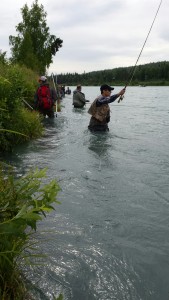 By 6 p.m. we were down river a few miles, nestled into a line of 40+ of our new best friends. To find open spots, we waded close to shore in fast water to our waists and above, navigating any number of large slippery rocks. We each had a 15-20 foot stretch of river to fish – we would flip the lure out 10 to 20 feet and bounce it along the bottom hoping for a curious or suicidal sockeye. Over the next three hours, Jon Thinks-Like-A-Sockeye caught two nice five- to eight-pound fish. Bill and I flunked our first test, and I tested my ability to recover from a wader-filling fall into the Kenai. 18,000 fish had entered the river on Thursday – not many were catching fish.
By 6 p.m. we were down river a few miles, nestled into a line of 40+ of our new best friends. To find open spots, we waded close to shore in fast water to our waists and above, navigating any number of large slippery rocks. We each had a 15-20 foot stretch of river to fish – we would flip the lure out 10 to 20 feet and bounce it along the bottom hoping for a curious or suicidal sockeye. Over the next three hours, Jon Thinks-Like-A-Sockeye caught two nice five- to eight-pound fish. Bill and I flunked our first test, and I tested my ability to recover from a wader-filling fall into the Kenai. 18,000 fish had entered the river on Thursday – not many were catching fish.
Friday’s count was 17,000 salmon into the Kenai. Saturday, Bill and I and a good many fishers around us were again skunked in the midst of our eight hours of combat fishing, while Jon caught his three. I fell into the river twice, as I gained my river legs, and Homey Bill – what a pal for not wanting me to feel like such a klutz – slipped in as well.
Sunday early morning, we headed upriver and hiked to a beautiful reach that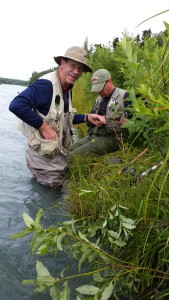 we had to ourselves – for an hour or so. Not enough fish that far upriver yet, but we had great fishing even without them. We headed downriver to another combat zone. There, Jon caught his three, I caught two trout and two salmon and Bill got skunked. I stayed dry in the river while Bill and Jon demonstrated their support for me by each slipping into the water. The previous day’s count was 20,000.
we had to ourselves – for an hour or so. Not enough fish that far upriver yet, but we had great fishing even without them. We headed downriver to another combat zone. There, Jon caught his three, I caught two trout and two salmon and Bill got skunked. I stayed dry in the river while Bill and Jon demonstrated their support for me by each slipping into the water. The previous day’s count was 20,000.
49,000 fish entered the Kenai Sunday, and Monday we fished two combat reaches. At one, we waded past 76 fishers to find our spots, and there were at least that many lined up on the opposite shore. With more fish in the river, everyone was catching. Bill hooked five and kept two, I lost three and kept one, and Dr. Jon hooked 10 and kept three.
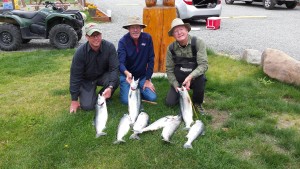 Tuesday, after another 54,000 fish made it to the river, we waded past 85 fishers to find our spots. There, it was Jon three, Jim three and Bill two. That evening we dropped Bill at the Kenai Airport for a flight to his annual family reunion in South Dakota.
Tuesday, after another 54,000 fish made it to the river, we waded past 85 fishers to find our spots. There, it was Jon three, Jim three and Bill two. That evening we dropped Bill at the Kenai Airport for a flight to his annual family reunion in South Dakota.
Wednesday morning at 4, Jon and I headed to the river for a few more hours of fishing before he caught up with the family reunion and I flew back to Paradise. Tuesday’s count had been a bit over 32,000. Jon caught one. We headed for Anchorage.
I would guess that, on any of the days we were fishing, there were well over 1,200 fishers on the river. We caught sockeye up to 10 pounds. We fished alongside laborers, heavy equipment operators, engineers and airline pilots. We were shoulder to shoulder with folks of a dozen languages and most every color and ethnic group on the planet. We talked with men and women from three countries (four if you count Minnesota) and a dozen states. We experienced great kindness and very bad behavior – people are people no matter where you go, I suppose. The fishing was a bit off normal, but we fished a great river Bill and I have long wanted to fish.
We had a great adventure.
Our Common Nighthawks and Lessons Learned
At dusk on Sunday evening I was distracted from my weeding – and swatting mosquitos – in the garden behind Evolutionary Abode. It was one of those familiar sounds that have the ability to sweep us away. The periodic raspy wing buzz of that nighthawk’s insect hunt took me back to a young boy’s decision.
Just about this time in July several decades ago, Cousin Ron (then ten) and I (then nine) were in a park near his home in Yakima. In that late evening, a dozen or more nighthawks were darting and cruising after insects a few yards above us.
Because we were young boys, we started tossing rocks just to watch them swerve. Then we hit one. I’m not sure whose rock it was, really, but I will never forget the feeling of watching that striking bird collapse in mid-air for the sake of our play. We walked back to Ron’s house, lost in feeling that we had done something very bad – a feeling I think you never forget – and we swore to never again kill something for no purpose and without a prayer.
Thankfully, we still have nighthawks here in Paradise.
Our common nighthawk is of a group of birds known as “goatsuckers.” As they fed around early European barnyards, legend grew that their huge mouths enabled them to suckle milk from lactating goats, but goatsuckers are just nocturnal insect eaters with large flat heads, tiny bills and cavernous mouths. Ours is also called “bull-bat” because of its bat-like feeding, scooping insects out of the air.
Shortly before dark, they swoop and knife erratically through twilight just above the treetops and house roofs. Their sharp call is a nasal, electric “peeent,” going on for a half-hour or more. Their flight is generally almost silent because of the soft comb-like or fimbriate (fringe-like) leading edge of the primary wing feathers (referred to as “flutings” or “fimbriae” in owls). Altering the spacing of primary wing feathers causes the distinctive “buzz” or “hum” or “boom” as they dive for a winged insect. These sounds draw many of us outside in the evening, looking for their source. (On one occasion, two of my favorite homeys were bear hunting in late August, when one of them mistook that raspy sound for a bear’s low grunt – an interesting few minutes, I hear.)
Nighthawks arrive in late May, and will breed anywhere there are insects – in sagebrush and semi-desert shrublands as well as urban and agricultural areas. Courtship rituals also mostly occur at dusk as the male calls, with that electric “cho-ic” or “che-wip,” circles, hovers or soars over his intended nest site, then swoops down, producing a loud hollow “boom,” almost crashing near his chosen mate. After as many as 40 of these dives, he may land, spread his tail, rock his upright body near the female, and puff out his white throat.
Nighthawks seem to sit funny; lengthwise on limbs, and diagonally on wires. Their short, weak legs barely allow them to waddle on the ground, contrasting with their amazing aerial abilities.
The birds nest on open ground – often along rivers or other gravelly stretches. Both the young and adults seem to just disappear into the ground. Two eggs are laid directly on a lightly excavated site with no nest. The female incubates them for 18 to 20 days, then both parents will regurgitate insects for the hatchlings. The young birds will fly at 18 days, feed at 25 days and are on their own in a month.
In eastern Washington, nighthawks are still fairly common, although numbers have decreased in the past 20 years. Pesticides may have reduced the amount of prey available, and some cite predation by crows as a factor.
In late August and September, our common nighthawks will begin their journey to South America. Some will winter over clear down into the grasslands of northern Argentina.
In keeping with the wishes of the Reecer Creek Rod, Gun, Working Dog & Outdoor Think Tank Benevolent Association’s Science Education Committee, I include the following. Common nighthawk’s scientific name is Chordeiles minor. It is a mottled, somewhat barred dark brown and gray bird, about nine inches long, with a broad-head and a wingspan of nearly two feet. Identifying traits include its white chin and wing patches, a slightly forked tail, and long pointed wings with a sharp distinctive falcon-like elbow (thus night”hawk”).
Find out more from “The Birder’s Handbook” by Paul R. Ehrlich, David S. Dobkin and Darryl Wheye, or another field guide. Online, I always start with the Cornell Lab site at http://www.allaboutbirds.org. You will find abundant opportunities on the web to hear the hums and booms and other vocalizations of our nighthawks – most any search engine will get you there.
Be grateful; our common nighthawks are great insect eaters – an analysis of one bird’s stomach turned up more than 500 mosquitoes in a single day of feeding, while another had more than 2,100 flying ants in its gut.
Comments Off on Our Common Nighthawks and Lessons Learned
Making Kids Have Outdoor Fun (?)
It was one of those small off-Reecer Creek meetings of the Reecer Creek Rod, Gun, Working Dog & Outdoor Think Tank Benevolent Association (aka RCRGWD&OTTBA). The questions on the floor were “How do we make our kids get outdoors and have fun?” and “Should we even try?”
Jacques Jesaistout (“Toot” we call him) opined that, given what he sees as a broad fear among parents of letting kids out of sight these days, our little think tank shouldn’t put too much energy into the argument. Lower County Homey argued that times are changing; he sees parents more and more pushing their kids out the door. He shrugged “And, who cares, anyhow? That’s drifting off the agenda item we’re debating!”
He was right, of course. Father-of-Three-Boy-Brats Tad lifted a hand. “We got so tired of the squabbling and their little noses in cell phones, tablets and TVs that we decided to do just that: make them go outside and enjoy themselves. We packed up a no-electronics day to Cooper Lake a couple weekends ago. We had fishing gear, firewood, hot dogs, s’mores stuff, and a list of things we decided we’d send them out to find if they started whining about being bored.”
“…And?” Toot asked.
“Some of it worked, and some of our careful planning was a waste,” Tad replied. “I helped them bait up and get their lines in the water. They’re like eight to twelve, so I left them watching rods and went to help their mom get chairs and stuff out of the car. After a while things got pretty quiet, so I went back down to the beach. Two of the rods were bouncing with fish – one half in water and the other more or less under the control of the twelve-year-old – but the younger boys were not there. When I asked where they were, he just sorta waved down the shore as he brought in a nice little trout. I hustled around a rocky point and there they were, turning over rocks, looking at bugs and whatever else they could find and do. They were so lost in jabbering and pointing and laughing that they didn’t even hear me come up.
“The whole day was like that. We’d get them re-focused on fishing or something and turn our backs, and some invisible force would drag them off to their own thing. The only time they followed our plan was getting the fire going, roasting wieners and making s’mores. After dark, we loaded up and headed home. They conked out about the time we pulled onto the gravel.
“Over breakfast this morning, they were still talking about bugs and fish and when we’re going again and why can’t they have s’mores for breakfast. I guess I’d say it was a great day with a fair amount of unnecessary planning.”
As we chuckled and shook our heads in agreement, I described a some-years-ago evening at McCabe with the Hucklings. Edward was probably eight and Anna and Tena somewhere around twelve and thirteen. It was a warm August “We’re bored…” evening, so I dragged them to the big pond at the mouth of the Canyon.
With their little spin cast outfits, they were soon catching little bass and other spiny rays on worms, with one or two lost-looking six-inch rainbows. At some point, Anna complained that she had some sort of snag, and the other two came running over to coach and cheer her on. Turned out it was a moving snag, and after ten or fifteen minutes, a five-pound catfish was flopping in the shallows. After a family vote, it was released back to its former life and all three Hucklings went back to their own fishing. Within minutes, two of the reels had bird-nests of tangled line. They decided to sit and watch as I showed them how to detangle the mess. Within seconds, I was alone. Moments later, I heard giggling and laughter from the other side of some willows, and went to investigate.
Clearly, detangling was not as entertaining as they’d thought. Edward found a six-foot length of monofilament with an old hook attached, Anna apparently found a long stick and Tena rounded up worm bits. With that setup, they caught and released at least a dozen three- or four-inch pumpkinseed sunfish. I gave up on the tangles and bathed in their joy and laughter ‘til dark.
After a couple more similar stories, Toot looked around. “Well, what have we learned today?”
Tad smiled. “Make kids get outside… And then get out of their way.”
That motion seconded and approved on a voice vote, the meeting adjourned.
Happy summer…
Comments Off on Making Kids Have Outdoor Fun (?)
Bats and Fireworks and Night Skies
Fireworks aren’t the only things in the night skies around our county in summer – and they may not even be the most interesting. Homey got me thinking about this when he reminded me of the pleasure I have taken from watching bats do their magic across an evening sky in the dying moments of sunset. “So where do we take the kids for a batty ‘watch and learn’ experience?”
We are bat blessed here in Paradise, even as a good many bat populations in the Pacific Northwest are in one or another level of stress. Among at least a dozen species, perhaps millions of bats inhabit our state. Most live entire lives without human contact. They spend days in caves, crevices and behind loose tree bark, house siding and shutters, emerging to eat the insect pests which often mess up our evenings.
You may have heard that bats – mammals – can’t really fly; they can only glide. Not so. Bats are skillful flyers, using tissue-thin wings attached along their sides and back legs. Wingspans are commonly three times or more their average four-inch body length – a ratio greater than most birds – so bat flight is fairly simple. Wings and bodies weigh far less than you might suspect; the tiny western pipistrelle, Pipistrellus hesperus, is three inches long, but weighs only 1/10th of an ounce, and our little brown bat, Myotis lucifugus, is three and a half inches long, weighing well under an ounce.
Bats are strong flyers, too, often hitting 40 miles per hour in spurts, skimming low over ground or water to catch insects and drink. The brown may travel 50 miles in a night of foraging.
The tiny mammals are good friends. A little brown bat will eat 3,000 mosquitoes in an evening. A flock of 100,000 insect-eating bats (not uncommon) may consume more than a ton of insects in the same time period. They sometimes fly into gatherings of insects, crippling them with their wings and scooping them into folds between their legs to be consumed as they continue to hunt.
“Blind as a bat?” Hardly; bats easily see predators and landscapes. For catching food, however, they use sonar, calling up to 200 times/second when “locked-on” to a target. From the return echoes, the bat learns what it needs to precisely intercept its insect meal. (In the minds of some scientists, bat sonar may still be superior to any we have created.)
After spring breeding, males and females separate. One or two babies may still be nursing on the wing while clinging to mother. Most babies will be flying at one month.
There is so much more to know. Check our Bat Conservation International (BCI) at www.batcon.org. BCI’s web page is one of the most amazing ways you and your family might spend an hour or so. There you will find all you ever wanted to know about building houses for bats, getting them safely out of yours or becoming part of something worldwide. The photography is remarkable, too.
Closer to home, you might be interested in the work and meetings of Bats Northwest, headquartered in Seattle. They have regular bat-watching tours around Green Lake and a web page (www.batsnorthwest.org/meet_our_bats.html) with a wealth of information about the status and health of Northwest bat populations.
Our bats are insect eaters, of the Vespertilionid family. Genus Myotis (the little brown) is most common, with Lasiurus (hoary) and Lasionycteris (silver-haired) often seen in wooded country. Most varieties have bodies around four inches long and wingspans of 10 to 12 inches; our largest bats may reach six inches, with wingspans of 16 inches. Bats are at home across the state. Most of ours hibernate here. Others fly south with the hoary bat to Chile or Argentina.
Now then, about Homey’s request. I like the beaver ponds up French Cabin Creek and along the hills on the west side of Lake Cle Elum, but pick most any pond, stream or arm of a lake (less than 100 feet across) in Paradise. Sit on the east side at dusk, and watch the bright western sky over the water until full darkness. Use insect repellant.
Grab a field guide and find a copy of Randall Jarrell’s “The Bat-Poet” (HarperCollins Publishers). This is the story of a small bat who stumbles across the joy of daylight. Exploring his sensitive artist self, ignored by his bat buddies, the bat poet begins to write poems about the fascinating things “normal” bats never see. He delights in the activities of birds, chipmunks, and others, writing poetry to describe daytime joys. Pen and ink sketches by Sendak complete the book. Read selections such as:
“…The mother drinks the water of the pond
She skims across. Her baby hangs on tight.
Her baby drinks the milk she makes him
In moonlight or starlight, in mid-air…”
Go watch. You will soon differentiate the species of bats, each with its own way of flying, hunting and drinking. Some may sing their songs of evening for you.
There are more – and more interesting – things than just fireworks in the night sky of Paradise.
Comments Off on Bats and Fireworks and Night Skies

